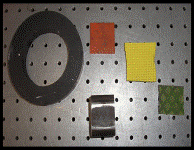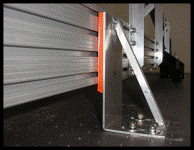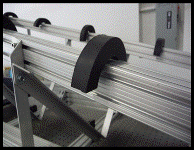





|
Design For Practice |
|
Northern Arizona University |
|
Development of Design (Page 2)††††††††††††††††††††††††††††††††† Previous Page |

|
Evolution from Design Selection |








|
After the design was selected at the end of the first term for capstone, we implemented the stiffening members system and modified the mounts as specified in our design. We then tested a variety of materials in traditional types of damping.†
Traditional types of damping include: viscous damping, coulomb damping and hysteretic damping.† Viscous damping uses the motion of a fluid to dissipate energy.† An example of this is a shock absorber in a car. Coulomb damping using the friction of two dry surfaces in oscillatory motion to dissipate energy.† Hysteretic damping uses the motion of molecules to dissipate energy through heat.
We first tested damping material between mount contact surfaces was compressive damping. This proved inadequate due to the constraints set fourth by our client.
Next we tried damping in compression at other locations. We soon came to realize that we were unable to apply a precise pressure needed to prevent the supports holding the damping material from lifting the structure off of the desired mounts.
After compression damping, were came to a road block until we talked to a Raytheon engineer who told us about damping in shear. We created brackets to hold damping material against the structure and tested them. The results showed no noticeable improvement and the implementation was not feasible either. We had to adjust the brackets constantly and in the end, the brackets were over constraining the model and preventing the structure from resting on itís mounts. We then decided to try tuned mass damping.
Tuned mass damping via spring was our actual intent. However, we decided to try a test with a interesting material called Sorbothane. We quickly found that this material greatly damped our structure. We cut the Sorbothane donuts in half and placed them on the angled members of the BBC.† We allowed the material to over hang off the structure to dissipate energy.
|



|
A few of the materials used in compression tests |
|
Sorbothane used in shear with bracket†††††††††††† |
|
Sorbothane half donuts used as tuned mass† dampers |